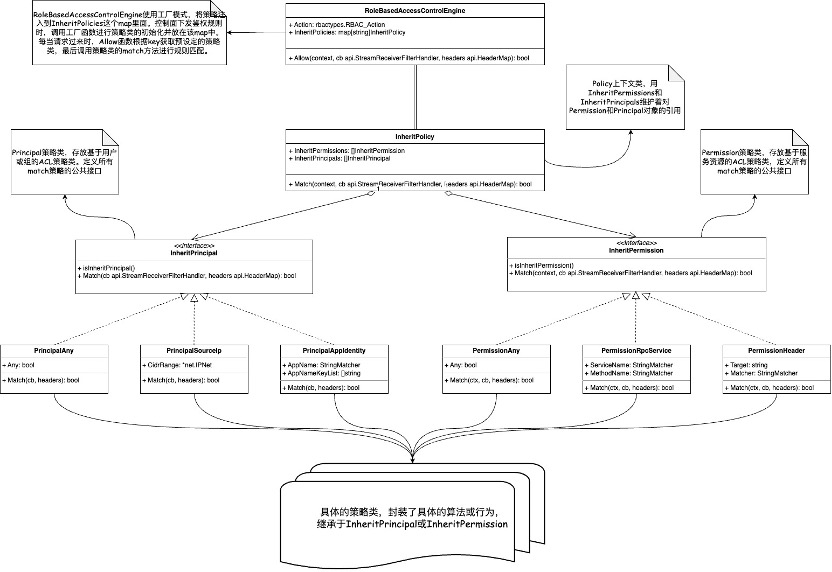策略模式
策略模式定义
策略模式是一种对象行为型模式。策略模式定义一系列算法,将每一个算法封装起来,并让它们可以相互替换,可以让算法独立于使用它的客户而变化。
主要角色和UML类图
主要角色
策略模式包含如下角色:
- Context: 上下文,context中定义了策略类,并且定义了一个方法,该方法在执行时会执行各具体策略中的方法。
- Strategy: 策略接口,该接口定义了一个方法,各具体的策略会实现该方法。
- ConcreteStrategy: 具体策略类,这些类都实现了Strategy策略接口中定义的方法。
- Client:客户端,在客户端中会创建Context上下文,并且指定具体的策略类,然后再执行Strategy策略接口中定义的方法。
UML类图

Mosn访问控制模块代码分析
mosn的访问控制模块使用了策略工厂模式,访问模块定义了InheritPrincipal和InheritPermission两种策略接口,每个策略接口又有不同的类实现策略接口中定义的方法。
uml类图如下所示:

以InheritPrincipal为例,在”filter/stream/rbac/common/principal.go”文件中首先定义了一个策略接口,该接口中有两个方法。最关键的是Match方法,不同的策略类都实现了该方法。
type InheritPrincipal interface {
isInheritPrincipal()
// A policy matches if and only if at least one of InheritPermission.Match return true
// AND at least one of InheritPrincipal.Match return true
Match(cb api.StreamReceiverFilterHandler, headers api.HeaderMap) bool
}
定义一个根据来源IP进行规则匹配的具体策略。
// Principal_SourceIp
type PrincipalSourceIp struct {
CidrRange *net.IPNet
}
func NewPrincipalSourceIp(principal *envoy_config_rabc_v3.Principal_SourceIp) (*PrincipalSourceIp, error) {
addressPrefix := principal.SourceIp.AddressPrefix
prefixLen := principal.SourceIp.PrefixLen.GetValue()
if _, ipNet, err := net.ParseCIDR(addressPrefix + "/" + strconv.Itoa(int(prefixLen))); err != nil {
return nil, err
} else {
inheritPrincipal := &PrincipalSourceIp{
CidrRange: ipNet,
}
return inheritPrincipal, nil
}
}
func (principal *PrincipalSourceIp) Match(cb api.StreamReceiverFilterHandler, headers api.HeaderMap) bool {
remoteAddr := cb.Connection().RemoteAddr()
addr, err := net.ResolveTCPAddr(remoteAddr.Network(), remoteAddr.String())
if err != nil {
panic(fmt.Errorf("[PrincipalSourceIp.Match] failed to parse remote address in rbac filter, err: %v", err))
}
if principal.CidrRange.Contains(addr.IP) {
return true
} else {
return false
}
}
定义一个根据Header进行规则匹配的具体策略。
// Principal_Header
type PrincipalHeader struct {
Target string
Matcher HeaderMatcher
InvertMatch bool
}
func NewPrincipalHeader(principal *envoy_config_rabc_v3.Principal_Header) (*PrincipalHeader, error) {
inheritPrincipal := &PrincipalHeader{}
inheritPrincipal.Target = principal.Header.Name
inheritPrincipal.InvertMatch = principal.Header.InvertMatch
if headerMatcher, err := NewHeaderMatcher(principal.Header); err != nil {
return nil, err
} else {
inheritPrincipal.Matcher = headerMatcher
return inheritPrincipal, nil
}
}
func (principal *PrincipalHeader) Match(cb api.StreamReceiverFilterHandler, headers api.HeaderMap) bool {
targetValue, found := headerMapper(principal.Target, headers)
// HeaderMatcherPresentMatch is a little special
if matcher, ok := principal.Matcher.(*HeaderMatcherPresentMatch); ok {
// HeaderMatcherPresentMatch matches if and only if header found and PresentMatch is true
isMatch := found && matcher.PresentMatch
return principal.InvertMatch != isMatch
}
// return false when targetValue is not found, except matcher is `HeaderMatcherPresentMatch`
if !found {
return false
} else {
isMatch := principal.Matcher.Equal(targetValue)
// principal.InvertMatch xor isMatch
return principal.InvertMatch != isMatch
}
}
此外,在”filter/stream/rbac/common/permissionl.go”文件中还定义了一个策略接口InheritPermission,同样有几个类实现了该接口。
type InheritPermission interface {
isInheritPermission()
// A policy matches if and only if at least one of InheritPermission.Match return true
// AND at least one of InheritPrincipal.Match return true
Match(cb api.StreamReceiverFilterHandler, headers api.HeaderMap) bool
}
在”filter/stream/rbac/common/policy.go”文件中,定义了上下文InheritPolicy,用于存储策略对象的引用并调用具体策略类的方法。
type InheritPolicy struct {
// The set of permissions that define a role.
// Each permission is matched with OR semantics.
// To match all actions for this policy, a single Permission with the `any` field set to true should be used.
InheritPermissions []InheritPermission
// The set of principals that are assigned/denied the role based on “action”.
// Each principal is matched with OR semantics.
// To match all downstreams for this policy, a single Principal with the `any` field set to true should be used.
InheritPrincipals []InheritPrincipal
}
定义了Match方法来调用具体的策略类方法。
// A policy matches if and only if at least one of its permissions match the action taking place
// AND at least one of its principals match the downstream.
func (inheritPolicy *InheritPolicy) Match(cb api.StreamReceiverFilterHandler, headers api.HeaderMap) bool {
permissionMatch, principalMatch := false, false
for _, permission := range inheritPolicy.InheritPermissions {
if permission.Match(cb, headers) {
permissionMatch = true
break
}
}
for _, principal := range inheritPolicy.InheritPrincipals {
if principal.Match(cb, headers) {
principalMatch = true
break
}
}
return permissionMatch && principalMatch
}
截止到这儿,核心的规则匹配方法已经完成,但是对于访问控制,匹配之后应该还有执行动作,比如通过或拒绝。mosn为此专门封装了一个引擎层,在”filter/stream/rbac/common/engine.go”文件中。为了减轻客户端维护不同策略算法的负担,使用了简单工厂来将不同策略维护在map中。
type RoleBasedAccessControlEngine struct {
// The request is allowed if and only if:
// * `action` is "ALLOWED" and at least one policy matches
// * `action` is "DENY" and none of the policies match
// default is ALLOWED
Action envoy_config_rabc_v3.RBAC_Action
// Maps from policy name to policy. A match occurs when at least one policy matches the request.
InheritPolicies map[string]*InheritPolicy
}
策略使用场景
- 一个系统需要动态地在几种算法中选择一种时,可将每个算法封装到策略类中。
- 一个类定义了多种行为,并且这些行为在这个类的操作中以多个条件语句的形式出现,可将每个条件分支移入它们各自的策略类中以代替这些条件语句。
- 系统中各算法彼此完全独立,且要求对客户隐藏具体算法的实现细节时。
- 系统要求使用算法的客户不应该知道其操作的数据时,可使用策略模式来隐藏与算法相关的数据结构。
策略模式优缺点
优点
- 策略模式符合开闭原则;
- 避免了使用多重条件语句。如 if…else…语句、switch语句;
- 使用策略模式可以提高算法的保密性和安全性。
缺点
- 客户端必须知道所有策略,并自行决定使用那种策略;
- 代码中会产生非常多的策略,增加维护难度;
- 如果业务逻辑不是很复杂,强行使用策略模式会增加程序的复杂度。
文档信息
- 本文作者:caitui
- 本文链接:https://caitui.github.io/2023/09/16/strategy-pattern/
- 版权声明:自由转载-非商用-非衍生-保持署名(创意共享3.0许可证)
